|
Outline - Electric Fields
|
|
- Difference between Action-at-a-Distance and Field Approach
- Action-at-a-Distance
- Assume one charge acts through a distance to exert a
force on another charge. (Fig. 1 below)

- The force F21 of q2 on q1
is equal in magnitude to
the force F12 of q1 on q2,
but opposite in direction.
Fe = F21 = F12 = q1q2/4peor2
= kq1q2/r2
where 1/4peo
= k = 9.0 x 109 N-m2/C2.
- Electric Field
- Assume distribution of charge sets up electric field
E at point P
(Fig. 2a below).

- A positive test charge q’ experiences a force
Fe = q’E
(Fig. 2b above)
- The magnitude of E is given by E = Fe/q’
- The direction of the electric field is that in which
a positive test charge is urged.
- The field is the property of charges setting up the
field.
- The electric force Fe is the response of
q’ to the electric field.
- The principle of superposition holds: If an object
is acted upon by two separate influences, it responds
to each without modifying its response to the other.
- Calculation of Electric Fields
- Field due to a point charge +Q at a distance r (Fig.
3)

- E = Fe/q’ = (kq’Q/r2)/q’
= kQ/r2

- Notice that the electric field depends on the magnitude
of Q and the distance r from it, but not on the test charge
q’.
- Field due to two charges (Fig. 4)

Field at P due to q1 = kq1/r12
to the right.
Field at P due to -q2 = kq2/r22
to the right.
Notice I did not put in the minus sign for field
due to q2. I asked what direction a positive test
charge placed at P would be urged by the field due to –q2
and saw that was to the right.
Resultant field at P is kq1/r12
+ kq2/r22 to the right.
When finding a field due to one or more charges you are not
asking about a force on the charge or charges that set
up the field. Think of the charges setting up the field as
set in concrete and assume they are fixed in position.
- Distribution of charges
Although charge is discrete, on a macroscopic level we can
consider that the charge is a continuous distribution.
- Element of charge dq on length dx is dq = ldx,
where l is the
charge per unit length.
- Element of charge dq on area dA is dq = sdA,
where s is the
charge per unit area.
- Element of charge dq on volume dV is dq = rdV,
where r is the
charge per unit volume.
- Apply principle of superposition. Use symmetry principle
to eliminate as many components as possible. Remember
that integration is not a vector addition.
- Examples
- Line of charge (Fig. 5)
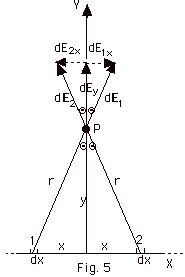
- Select symmetrically disposed elements of length
dx and charge dq = ldx,
where l is the
charge per unit length. The field due to each element
at point P, dE1 = dE2
= kdq/r2.
- As shown in Fig. 5, the X components of dE2x
and dE1x cancel.
- You are left with the Y components dE1
cos Q = dE2
cos Q
= dE cos Q = (kdq/r2)
cos Q = k(l
dx) cos Q/r2.
- The variables are x, r, and Q,
while y is a constant. To integrate you must get the
expression for dE cos Q
in terms of one variable.
- Since x = y tan Q,
dx = y sec2QdQ.
Also r = y sec Q
or
r2 = y2sec2 Q
and
E = kl (dx) cos
Q/r2
= kl(y
sec2QdQ)cosQ/(y2sec2
Q)
= kl
cos QdQ/y.
E = (kl/y) ∫cos
Q dQ
The final answer depends on the limits. For
an infinitely long line of charge,
Q goes
from -p/2
to +p/2
and
E = 2kl/r =
l/2peor.
- The electric field at the center of a semicircle loop
of radius R carrying uniform charge Q distributed uniformly
over its length (Fig. 6).
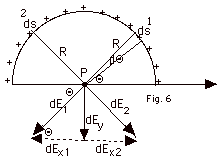
- Take symmetrically distributed elements 1 and 2
of length ds and charge dq = lds.
Since dQ
= ds/R in radians, dq = lRdQ.
- dE1 = dE2 = kdq/R2
= dE.
The directions are as shown in Fig. 6.
The X-components of dE1 and dE2
cancel.
dEy = dE sin Q
= (kdq/R2) sin Q
= klRdQsin
Q/R2
= kldQsin Q/R.
- E =

- Since l= charge/length
= Q/pR,
E = 2k(Q/pR)R
= 2(1/4peo)(Q/pR2)=
Q/2 p2eoR2.
E = - Q/2p2eoR2
j.
- Electric Field due to a Uniformly Charged Disk (Fig.
7)
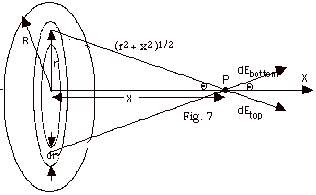
Divide the disk into rings of radius r and thickness dr.
If you cut the ring and pull it out into a rectangle,
it has length 2pr
and thickness dr. Its area dA = 2pr
dr. If its charge per unit area = dq/dA = s,
dq = sdA = s2pr
dr. The field due to a small amount of charge dq at the
top of the ring of radius r is dEtop
= kdq/(x2 + r2) down and
to the right as shown in Fig. 7. The electric field
for an equal amount of charge dq from the bottom
is dEbottom = kdq/(x2 + r2)
up and to the right as shown in Fig. 7. The
dE's from the entire ring form a cone about point P. The
components in the Y and Z direction cancel, leaving the
resultant field in the +X - direction.
The component of the dE in the X-direction is:
kdq/(x2 + r2) cos Q.
From Fig. 7, we see that cos Q
= x/(x2 + r2)1/2, so
dEx = kdq/(x2 + r2)
cos Q = kdqx/(x2
+ r2)3/2.
For the ring of Fig. 7 with charge s2pr
dr,
dE = k(s2pr)xdr/(x2
+ r2)3/2

- Electric Flux FE
- Definition

dA is an element of area.
The direction of dA is that of the outward normal to
the surface.
- Examples

- Gauss's Theorem
-
 . .
- FE
is the total flux crossing a three dimensional surface.
 is
the integral around a closed three dimensional surface. is
the integral around a closed three dimensional surface.
- Application
Choose Gaussian surface that gives maximum symmetry properties
such that:
- E is normal to the surface, that is, the angle
between E and dA is zero and E .
dA = E dA cos 0o = E dA.
- E is constant everywhere on the surface, that is,
 . .
- Examples
- Spherically symmetrical distribution of charge (Fig.
10)
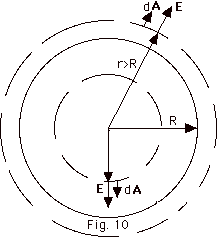
- For hypothetical Gaussian surfaces (shown by dashed
cross-section of spheres in figure above), choose
sphere. E must be normal to surface and
constant at any point on a Gaussian surface or the
symmetry of a sphere would be unraveled by rotating
it.
For r > R or
r < R,  E,
dA must be zero and E is constant everywhere
on the Gaussian surface. E,
dA must be zero and E is constant everywhere
on the Gaussian surface.

- Continuity Conditions
For r ≤ R at r = R, E
= Q/4peoR2
For r ≥ R at r
= R, E = Q/4peoR2
- Field of a cylinder (Fig. 11)
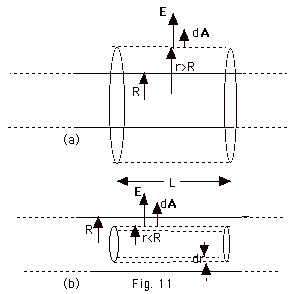
- For hypothetical Gaussian surface choose cylinder
coaxial with the real cylinder. E must be normal
to the surface and constant at any point on cylinder
or symmetry of cylinder would be unraveled by rotating
it.
For r < R or
r > R,  E,
dA = 0 and E is constant everywhere on the
Gaussian surface, so E,
dA = 0 and E is constant everywhere on the
Gaussian surface, so
-


For r > R, charge enclosed = (charge/length)L
= lL,
E(2prL) = lL
or
E = l/2peor
(Fig.
11 a)
For r < R, charge enclosed = (charge/volume)(volume)
= r(pr2L),
E(2prL) = r(pr2L)/eo
or
E = rr/2eo
(Fig.
11 b)
- Continuity conditions
For r ≥ R at r = R, E
= l/2peoR
For r ≤ R at r = R, E
= rR/2eo
= [Q/(pR2L)]R/2eo
=
(Q/L)/2peoR
=
l/2peoR
- Field of an infinite flat sheet of charge (Fig.
12)
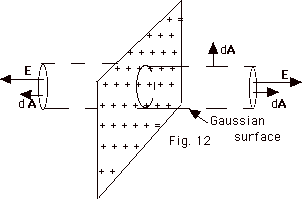
- For a hypothetical Gaussian surface choose a beer
can with ends parallel to the sheet.
- Electric field must be perpendicular to sheet and
independent of distance from sheet to preserve symmetry
property of an infinite plane.
For end caps of beer can,  E,
dA = 0. E,
dA = 0.
For sides of beer can,  E,
dA = 90o. E,
dA = 90o.
- For end caps of beer can, taking into consideration
both ends,

For sides of beer can, E dA cos 90o = 0.
- Conductors
- The definition of a conductor is that electrons are perfectly
free to move in it. If they are free to move, they will
move until there is no electric field in the conductor.
- By Gauss's law,
 . .
If there is no electric field in the conductor, then a Gaussian
surface very near the surface of the conductor contains no
charge. The charge must be on the outside of the conductor.
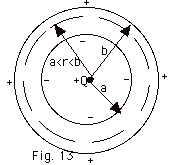
- Figure 13 above shows the cross-section of a spherical
shell of inner radius a and outer radius b. At the center
of the shell is a point charge +Q. The Gaussian surface
of radius r such that a < r < b is inside
the conductor so there can no be field there. The +Q
charge attracts electrons so that the charge on the inside
of the conducting shell is –Q, leaving the outside
of the shell positively charged with +Q. While the charge
on the surface of radius a is the same as the surface of radius
b, the charge per unit area on each is not the same.
sb = +Q/2pb2
and
sa = - Q/2pa2
- Electric Field of a Dipole
- Description
- Dipole consists of two point charges of opposite sign,
but equivalent quantity of charge.
- The charges are separated by a distance d = 2a
in Fig. 14 below.

- We are often interested in cases for which the distance
from the center of the dipole to the point P where we
wish to find the electric field is much greater than d
the distance of separation of the charges.
- Calculation of E for point on perpendicular bisector (Fig.
14)
- At P, the electric field due to the positive
charge is
E+ = kq/r2 = kq/(a2 +
y2)
upward along the line connecting +q and P.
- At P, the electric field due to the negative
charge is
E+ = kq/r2 = kq/(a2 +
y2)
downward along the line connecting - q and P.
- Notice that the magnitudes of the field due to +q and
- q are equal. In Fig. 14, we see the Y-components
of the electric field due to +q and the electric field
due to -q, (E+)y and
(E2)y , respectively, cancel.
- The components of the electric field in the X-direction,
(E+)x = E1 cos Q
and (E2)x = E2 cos Q, are
equal because E1 = E2. These components
are in the same direction, so they add. The total electric
field at P due to both charges E = 2[kq/(a2
+ y2)] cos Q.
From the figure, we see that cos Q
= a/(a2 + y2)1/2, so
E = k(2qa)/(a2 + y2)3/2.
- For y >> a, E = k(2qa)/y3
= k(qd)/y3 = kp/y3, where
p is called the dipole moment. We can make p a vector
quantity by taking its direction from the minus charge
to the positive charge. The direction of the electric
field in Fig. 14 is in the negative X-direction,
so we may write for y >> a, E =
- kpi/y3.
- Calculation for electric field on axis of dipole (Fig.
15)
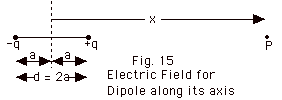
- Electric field at P due to - q is kq/(x + a)2
to the left.
- Electric field at P due to +q is kq/(x - a)2
to the right.
- Taking to the right to be positive, the total electric
field at P due to both charges is
E = kq[1/(x - a)2 - 1/(x + a)2]
= kq{(x + a)2 - (x - a)2}/(x2
- a2)2
= kq{x2 +2ax + a2
- x2 +2ax - a2}}/(x2
- a2)2
= k4aqx/(x2 - a2)2
= 2kpx/(x2 - a2)2
For x >> a, E = 2kp/x3
and E = 2kpi/x3.
Again for great distances, E is inversely proportional
to the cube of the distance from the center of the dipole.
- Two Problems Concerning Electric Fields
- One problem is, given a distribution of electric charges,
find the field due to them. For non-symmetrical distributions,
we have used a vector addition of the field due to each charge
or element of charge. For symmetrical distributions, we have
used Gauss's theorem.
- The other problem is, given an electric field E,
find the force on a charge particle in the field. Since the
electric field is the force per unit charge, Fe = qE.
If the charge is positive, the force will be in the
same direction of the field. If the charge is negative, the
force will be opposite to the direction of the field.
- Torque on a dipole in an Electric Field
- Dipole moment p = qd. The direction of p is
from the minus charge to the plus charge.
- In a constant electric field, the force on the positive
charge F+ = qE to the right and the force on the
negative charge F- = qE to the left, as illustrated
in Fig. 16 below.

- The torque due to F+ about an axis through a
point half way between the charges is (qEd/2) sin
 E,
p into the page. The torque due to F- is
also (qEd/2) sin E,
p into the page. The torque due to F- is
also (qEd/2) sin  E,
p into the page. The total torque = qdE sin E,
p into the page. The total torque = qdE sin  E,
p into the page. A convenient way of writing the torque
is t = p x E. E,
p into the page. A convenient way of writing the torque
is t = p x E.
- Sample Problems from 108
Problem Set for Electric Fields: 1-8, 10, 14-17,
19-27.
|
|